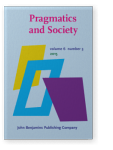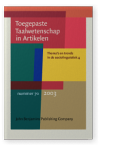Kees de Glopper
List of John Benjamins publications for which Kees de Glopper plays a role.
Journal
2020 Text selection proposals in dialogic reading in primary school Pragmatics and Society 11:4, pp. 591–614 | Article
In dialogic reading during inquiry learning in primary school, pupils read, think and talk together about text fragments for answering their research questions. This paper demonstrates from a conversational analytic perspective, how the shared activity of text selection is constructed in a goal… read more
2015 Shared reading at kindergarten: Understanding book content through participation Pragmatics and Society 6:3, pp. 367–397 | Article
This paper presents a single case-study of a longitudinal shared reading programme that took place in Dutch kindergartens with first language speakers of 4 to 6 years old. As will be shown, children participate both in a traditional instructional structure and in a participation framework… read more
2010 De Interactie Tussen Leiding en Kinderen En Tussen Kinderen Onderling in Twee Verschillende Typen Buitenschoolse Opvang Toegepaste Taalwetenschap in Artikelen 84/85, pp. 135–144 | Article
In this paper we will show how different types of after-school day care (bso) influences discourse between caretakers and children. In field research carried out in the context of a PhD-study on the social development and discourse practices of young children in after-school day care, a continuum… read more
2009 Participeren Tijdens het Voorlezen van Prentenboeken in de Kleuterklas: Een Pilot-Study Toegepaste Taalwetenschap in Artikelen 81, pp. 53–63 | Article
This paper describes a pilot-study that explores situated learning at kindergarten. By whole-class shared book reading, children get to know several participation frame-works, in which they gradually learn to participate during a longitudinal reading-aloud program. Using qualitative conversation… read more
2009 De Ontwikkeling Van Een Instrument Voor Het Meten Van De Voorleeservaring Van Kleuters Toegepaste Taalwetenschap in Artikelen 82, pp. 69–80 | Article
When children enter school at the age of four, they are expected to differ in their experience with reading-aloud of picture books and stories. Experience with reading-aloud influences their further development. Therefore, insight in the amount of experience with reading-aloud is useful. Until… read more
2007 Leerzame Gesprekken? Interacties met kleuters tijdens voorleessessies In gesprek, pp. 85–94 | Article
Kindergarten teachers who are talking with their nursery children during picture book reading about social and emotional themes, speak about the experiences and emotions of book characters, but also about the feelings of the children themselves. In both contexts the teachers tend to structure the… read more
2003 Tekstbegrip Van Wiskundetaken: Een Moeilijke Opgave? Thema's en trends in de sociolinguistiek 4, pp. 91–101 | Article
In secondary education, mathematics education has been highly influenced by Realistic Mathematics, which means that mathematical problems are presented in rich linguistic contexts. In order to solve the mathematical problem, students have to make a correct representation of the problem, and this… read more
1998 Modellen en Metingen Van Taalvaardigheid Toegepaste taalwetenschap in discussie, pp. 169–178 | Article
This article contains a concise discussion of models and measurement of language ability. A general definition of the concept language ability is given, Subsequendy, psycholinguistic models of oral and written language production and comprehension are discussed. The nature and extent of individual… read more
1992 8. Large scale writing assessment The Construct of Language Proficiency: Applications of psychological models to language assessment, Verhoeven, Ludo and John H.A.L. de Jong (eds.), pp. 101–114 | Article









